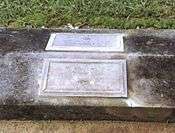John Gildroy Grant
| John Gildroy Grant | |
|---|---|
| Born |
26 August 1889 Hawera, New Zealand |
| Died | 25 November 1970 (aged 81) |
| Allegiance | New Zealand |
| Service/branch | New Zealand Military Forces |
| Years of service | 1915–29 |
| Rank | Lieutenant |
| Unit | Wellington Infantry Regiment |
| Battles/wars |
First World War |
| Awards | Victoria Cross |
John Gildroy Grant, VC (26 August 1889 – 25 November 1970) was a soldier in the New Zealand Military Forces during the First World War. He was a recipient of the Victoria Cross, the highest award for gallantry in the face of the enemy that can be awarded to British and Commonwealth forces.
Early life
Born on 26 August 1889 in Hawera,[1] a small town in the Taranaki region of New Zealand, Grant was working as a builder when he volunteered for the New Zealand Expeditionary Force (NZEF) in June 1915.[2]
Military career
At the time of Grant's enlistment, the NZEF was engaged in the Gallipoli Campaign and after initial training, he embarked for the Middle East in October 1915. He joined the 1st Battalion, Wellington Infantry Regiment of the New Zealand Division, then being formed in the aftermath of the evacuation from the Gallipoli Peninsula. It duly embarked for the Western Front.[2]
Grant served with the battalion throughout 1916 and 1917, and the following year had reached the rank of sergeant. He was 29 years old when he performed the deed for which he was awarded the Victoria Cross. On 1 September 1918 near Bancourt, the leading waves of the battalion on reaching a crest of high ground, found that a line of enemy machine-gun posts offered a serious obstacle to further advance. The company, however, advanced against these posts under point-blank fire, and when about 20 yards (18 m) away Grant, closely followed by a comrade, rushed ahead of his platoon, entering the centre post and demoralising the garrison so that the platoon were able to mop up the positions. In the same manner he rushed the post on the left and the remaining posts were quickly occupied and cleared by his company.[3][2]
Shortly afterwards, Grant was promoted to second lieutenant and traveled to Cambridge in England for officer training in October 1918. He was wounded in November, within days of his return to the front. His service with the NZEF ended with his repatriation to New Zealand in 1919.[1]
Later life

Grant remained involved with military life, serving in the Territorial Force until 1929, by which time he had reached the rank of lieutenant. He was discharged due to his age and also for being unable to attend camp. He later worked in Paeroa, becoming noted for his erratic behaviour which meant he found it difficult to gain employment. Undiagnosed at the time, it is thought that Grant suffered from post-traumatic stress disorder.[2] Grant died at the age of 81, and is buried in Waikumete Cemetery in Auckland.[2]
Grant's Victoria Cross was displayed at the QEII Army Memorial Museum, Waiouru, New Zealand. On 2 December 2007 it was one of nine Victoria Crosses that were among a hundred medals stolen from the museum.[4] On 16 February 2008, New Zealand Police announced all the medals had been recovered as a result of a NZ$300,000 reward offered by Michael Ashcroft and Tom Sturgess.[5]
Notes
- 1 2 "Lieutenant John Gildroy Grant". Auckland War Memorial Museum Cenotaph Database. Retrieved 2012-05-19.
- 1 2 3 4 5 Harper & Richardson, 2007, pp. 169 – 171
- ↑ "No. 31034". The London Gazette (Supplement). 26 November 1918. p. 14040.
- ↑ Derek Cheng (December 2007). "Army medal theft 'insult' to our nation's heritage". nzherald. Retrieved 2007-12-02.
- ↑ NZPA (February 2008). "Medals stolen from Waiouru Army Museum recovered". nzherald. Retrieved 2012-05-22.
References
- Harper, Glyn; Richardson, Colin (2007). In the Face of the Enemy: The Complete History of the Victoria Cross and New Zealand. Auckland, New Zealand: HarperCollins Publishers (New Zealand) Limited. ISBN 1869506502.
External links
- New Zealand Troops who have won the Victoria Cross at the Wayback Machine (archived October 26, 2009) (brief biography details)